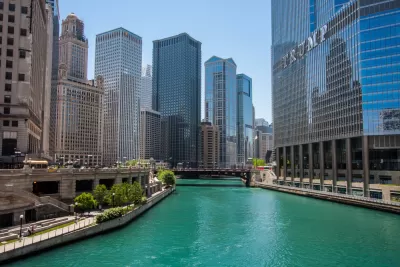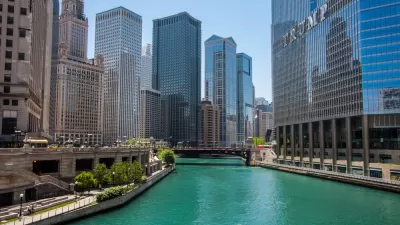The most conspicuous example of Chicago's recent spat of troubling signage is a 2,891-square-foot sign 200 feet above street level on the Trump International Hotel and Tower in Chicago.

"It's a sign-plastered world out there, and nothing, not even Wrigley Field, is safe or sacred….Signs are so pervasive that we've become numb to them and their impact on our psyches and surroundings," writes Chicago Tribune architecture critic Blair Kamin.
Kamin calls the sign an "on-steroids version of Trump's ubiquitous logo and its bold serif typeface," and most troubling is the impact the sign has on the street: "The big letters loom over the beaux arts Michigan Avenue Bridge and the great skyscrapers, from the wedding cake of the Wrigley Building to the corncobs of Marina City, that are visible from the span. To be sure, the nearby Tribune Tower has a prominently displayed sign, but it's on an attached structure, not the neo-Gothic skyscraper itself. The Trump sign, by comparison, is a poke in the eye."
Kamin's larger point is that Trump sign is only the most recent example of carte blanche granted to signage in the city, which lacks "sophisticated design guidelines as well as the teeth to enforce them."
Other writers have also produced strong critiques, including Neil Steinberg of the Chicago Sun-Times, who cites the sign as a symbol of the "emptiness of vanity." Writes Steinberg: "Who does this sign benefit? Out-of-towners who pass by and wonder which building this is? The hotel and condo owners ballyhooing themselves? As bad as being Donald Trump undoubtedly is, being caught basking in his glow is even worse."
FULL STORY: Donald Trump: Giant sign on his Chicago tower is like Hollywood sign

Study: Maui’s Plan to Convert Vacation Rentals to Long-Term Housing Could Cause Nearly $1 Billion Economic Loss
The plan would reduce visitor accommodation by 25,% resulting in 1,900 jobs lost.

Placekeeping: Setting a New Precedent for City Planners
How a preservation-based approach to redevelopment and urban design can prevent displacement and honor legacy communities.

Using Old Oil and Gas Wells for Green Energy Storage
Penn State researchers have found that repurposing abandoned oil and gas wells for geothermal-assisted compressed-air energy storage can boost efficiency, reduce environmental risks, and support clean energy and job transitions.

Washington State Plans Ambitious ‘Cycle Highway’ Network
The state is directing funding to close gaps in its existing bike network and make long-distance trips more accessible.

Homeowners Blame PG&E for Delays in ADU Permits
The utility says it has dramatically reduced its backlog, but applicants say they still face months-long delays for approvals for new electrical work.

Rethinking Wildfire Defense: How a Landscape Approach Can Protect Neighborhoods
Post-fire analysis of the Eaton Fire reveals that a landscape approach — including fire-resistant vegetation, home hardening, and strategic planning — can help reduce wildfire risk, challenging assumptions that trees and plants are primary fire hazards.
Urban Design for Planners 1: Software Tools
This six-course series explores essential urban design concepts using open source software and equips planners with the tools they need to participate fully in the urban design process.
Planning for Universal Design
Learn the tools for implementing Universal Design in planning regulations.
Borough of Carlisle
Caltrans
Heyer Gruel & Associates PA
Institute for Housing and Urban Development Studies (IHS)
City of Grandview
Harvard GSD Executive Education
Salt Lake City
NYU Wagner Graduate School of Public Service
City of Cambridge, Maryland



























